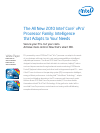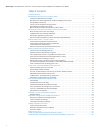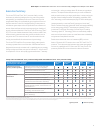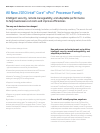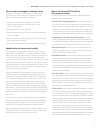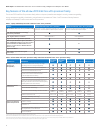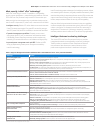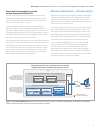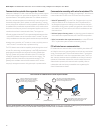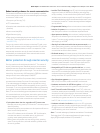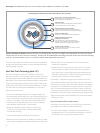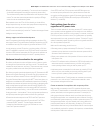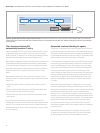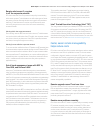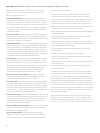
7
White Paper: The All New 2010 Intel® Core™ vPro™ Processor Family: Intelligence that Adapts to Your Needs
What, exactly, is Intel® vPro™ technology?
Intel® vPro™ technology is a set of IT capabilities – manageability,
security, power management – embedded into the hardware of all new
2010 Intel Core vPro processor family-based PCs. Because the capa-
bilities are built into the hardware, they are available virtually anytime,
even if the OS is inoperable, PC power is off, or the hard drive has failed.
• Intelligent security. Disable a PC and/or disable access to the data even
if the PC is already lost or stolen. Encrypted PCs are also fully manage-
able if PC power is off, the OS is unavailable, or the hard drive has failed.
• Expanded management capabilities. Remotely access, control,
and manage client PCs “as if you were there” with hardware-based
KVM Remote Control. Save power and keep up with compliance by
scheduling PCs to wake from off to run local tasks according to policy.
• Improved power management and rapid ROI. Realize rapid ROI
simply by implementing better power management enabled by
Intel vPro technology.
Intel vPro technology takes advantage of an intelligent processor, chipset,
and networking silicon features, along with protected flash memory. When
combined with existing independent software vendor (ISV) consoles that
support Intel vPro technology, Intel vPro technology can deliver a compre-
hensive, tamper-resistant solution for security and manageability.
A key benefit of being embedded in hardware is that the capabilities
are less susceptible to the problems that typically affect an OS, appli-
cations or hard drive. For example, because Intel vPro technology is
designed into PC hardware, it is resistant to tampering, boot issues,
and other problems that can affect an OS and/or security applications.
Intelligent features to solve key challenges
The all new 2010 Intel Core vPro processor family can provide a
comprehensive solution to manageability and security challenges.
Table 3 provides an overview of some of the features of these
new processors. New features and some of the more critical
proven technologies are described in detail later in this paper.
Table 3. Key IT challenges and solutions addressed with a new 2010 Intel® Core™ vPro™ processor-based PC.
Challenge Solution
a
PCs unmanageable when
powered down
1
Remotely and securely monitor and manage PCs anytime:
• Access the PC even if PC power is off, the OS is unresponsive, management agents are missing, or hardware
(such as a hard drive) has failed.
• Access critical system information (asset information, event logs, BIOS information, etc.) virtually anytime, even if
PC power is off, to identify systems that need maintenance or service.
• Remotely and securely power up PCs for maintenance and service, initiated by the service center.
• PC Alarm Clock, in which client-side intelligence performs a scheduled wake from any powered off or sleep states, so
the PC itself can call in and initiate a maintenance, security or other task off-hours.
Unsecured communications with PCs
More securely communicate with laptop and desktop PCs both inside or outside the corporate rewall:
• Secure, remote communication inside the rewall.
• Secure, remote communication outside the rewall, on an open wired or wireless LAN.
Spiraling and costly deskside visits
Signicantly reduce deskside visits with:
• Remote remediation, even if management agents are missing or the OS is unresponsive.
• Remote problem resolution, even if the OS is unresponsive or hardware (such as a hard drive) has failed.
• KVM Remote Control
2
to help resolve complex issues, so you can see exactly what the user sees, and repair the PC
more effectively from a remote location.
Protect assets from
software-based attacks
Protect assets better:
• Remotely power up PCs anytime to help ensure more complete saturation for patching and other updates.
• Built-in, programmable system defense lters and agent-presence checking for automated, hardware-based
protection against viruses and attacks.
Thwart thieves – secure assets and
data even if the PC is lost or stolen
4
Disable or “brick” a PC and/or protect its data virtually anytime:
• Poison-pill to “brick” a lost or stolen PC; data is not destroyed or lost in the process, and reactivation is rapid, simply by
entering an authentication token.
• Remote notication via a 3G modem in a cell phone, to ag a system that might be in the process of being stolen.
• Built-in, programmable triggers and responses to protect data and the PC after loss or theft of the system.
4
• Intelligent, policy-based PC-side timers that trigger a lockdown if the user has not logged in before timer expiry.
Lack of conguration compliance
Ensure compliance:
• Remote inventory and agent presence checking as a hardware-based, automated, policy-based service.
Costly and time-consuming
manual inventories
Eliminate virtually all manual inventories:
• Accurate, remote asset inventories, even if PCs are powered off or management agents are missing.
Undiscoverable assets
Discover virtually all PCs:
• Persistent device ID available anytime, even if PC power is off, the OS has been rebuilt, hardware or software
conguration has changed, or the hard drive has been reimaged.
Reimage systems without
a deskside visit
Reduce deskside visits, speed up remote deployment, and minimize user interruptions:
• Remotely reimage systems even if PC power is off at the start of the upgrade cycle.
a
IT must activate Intel® vPro™ technology in order to take advantage of these intelligent security and remote manageability technologies. For more information about activating Intel vPro technology, which includes
Intel® AMT and Intel® AT, see page 25 of this white paper.



